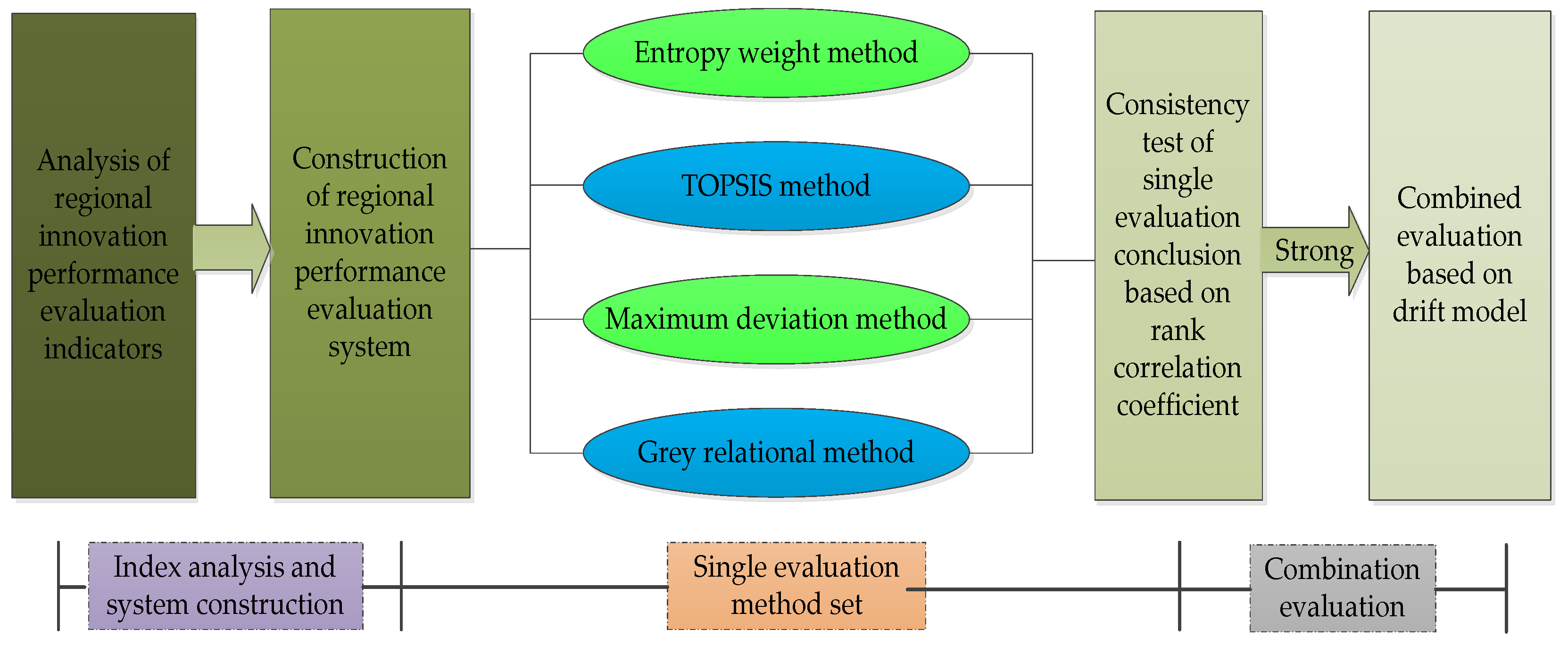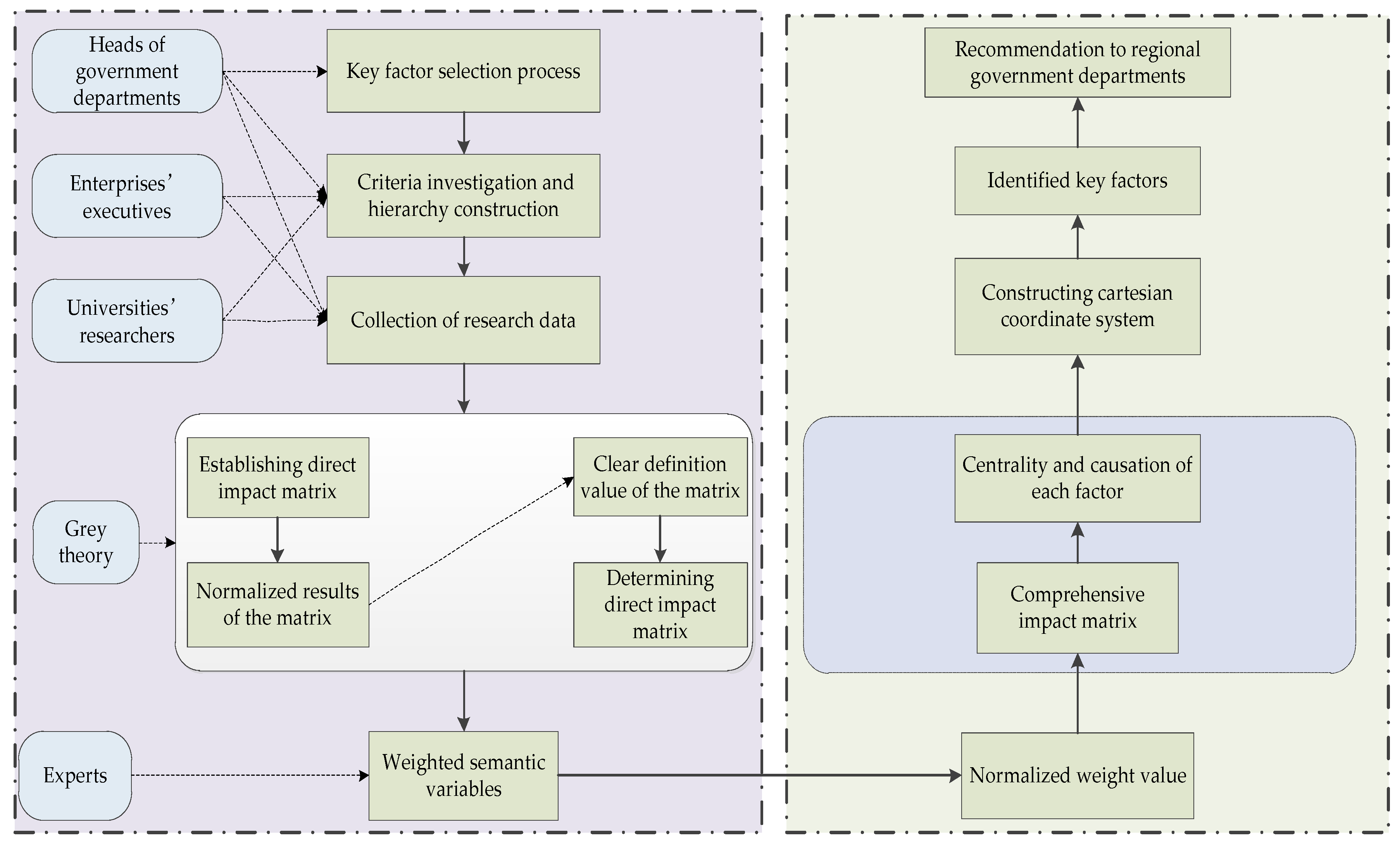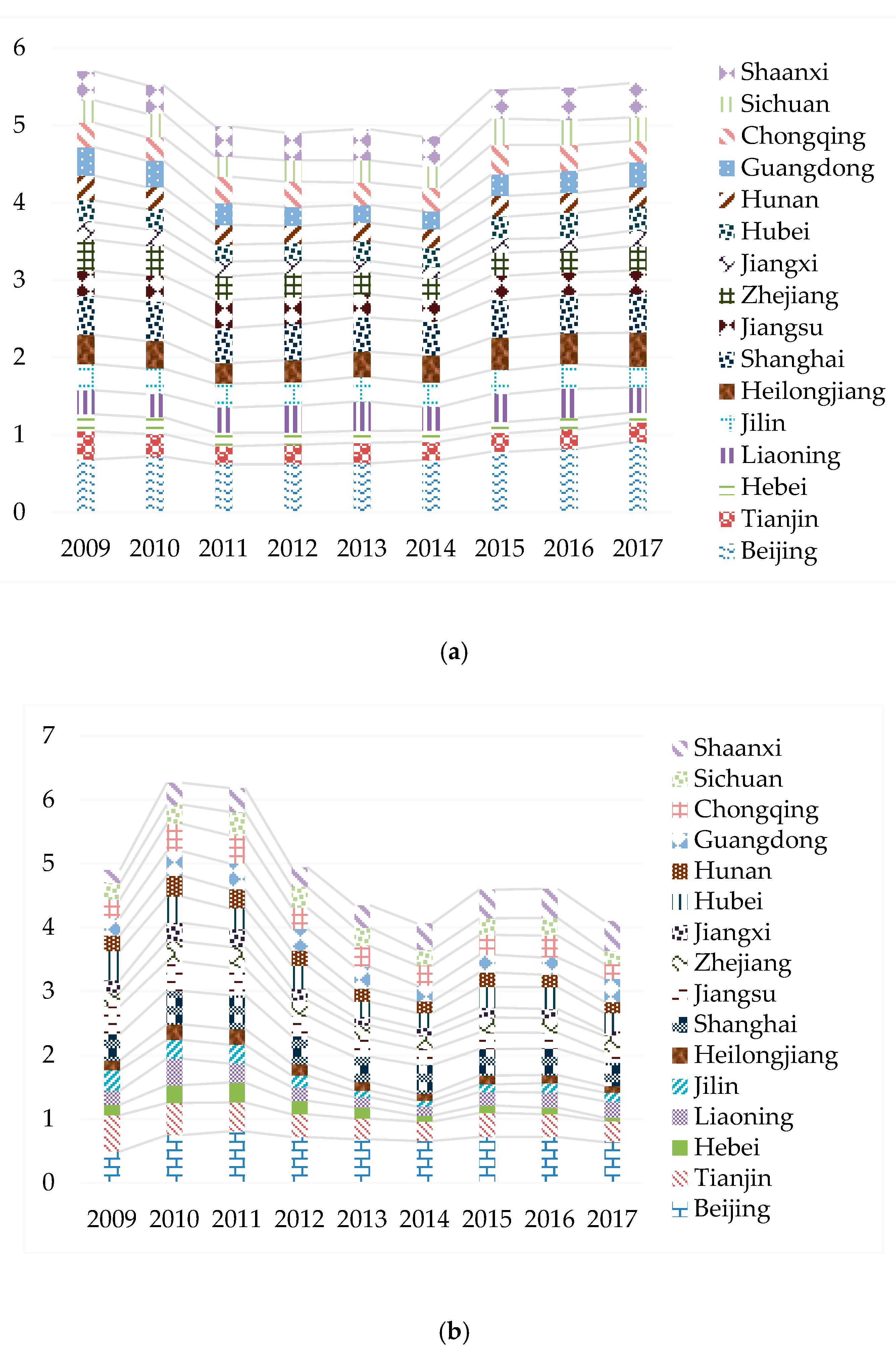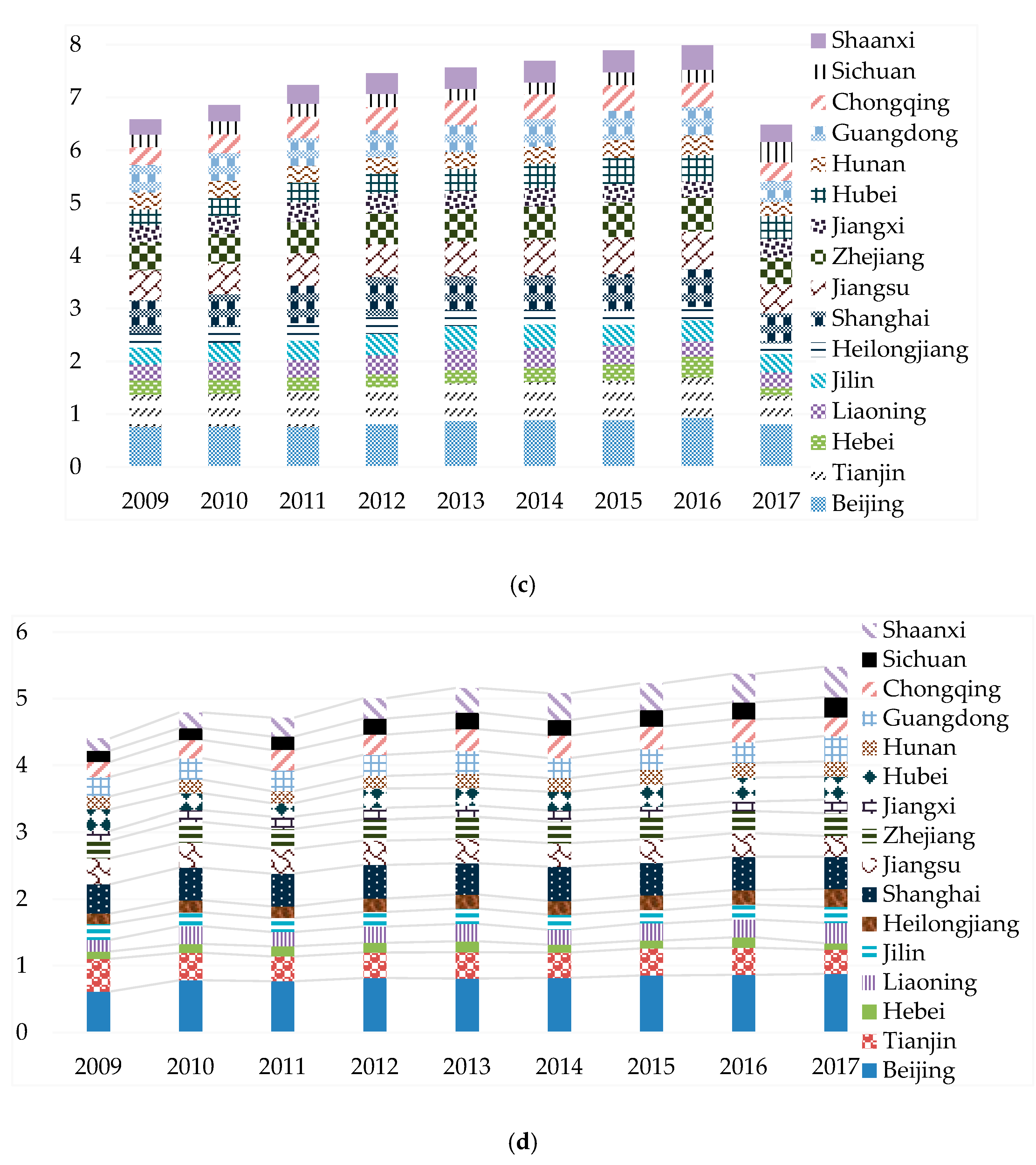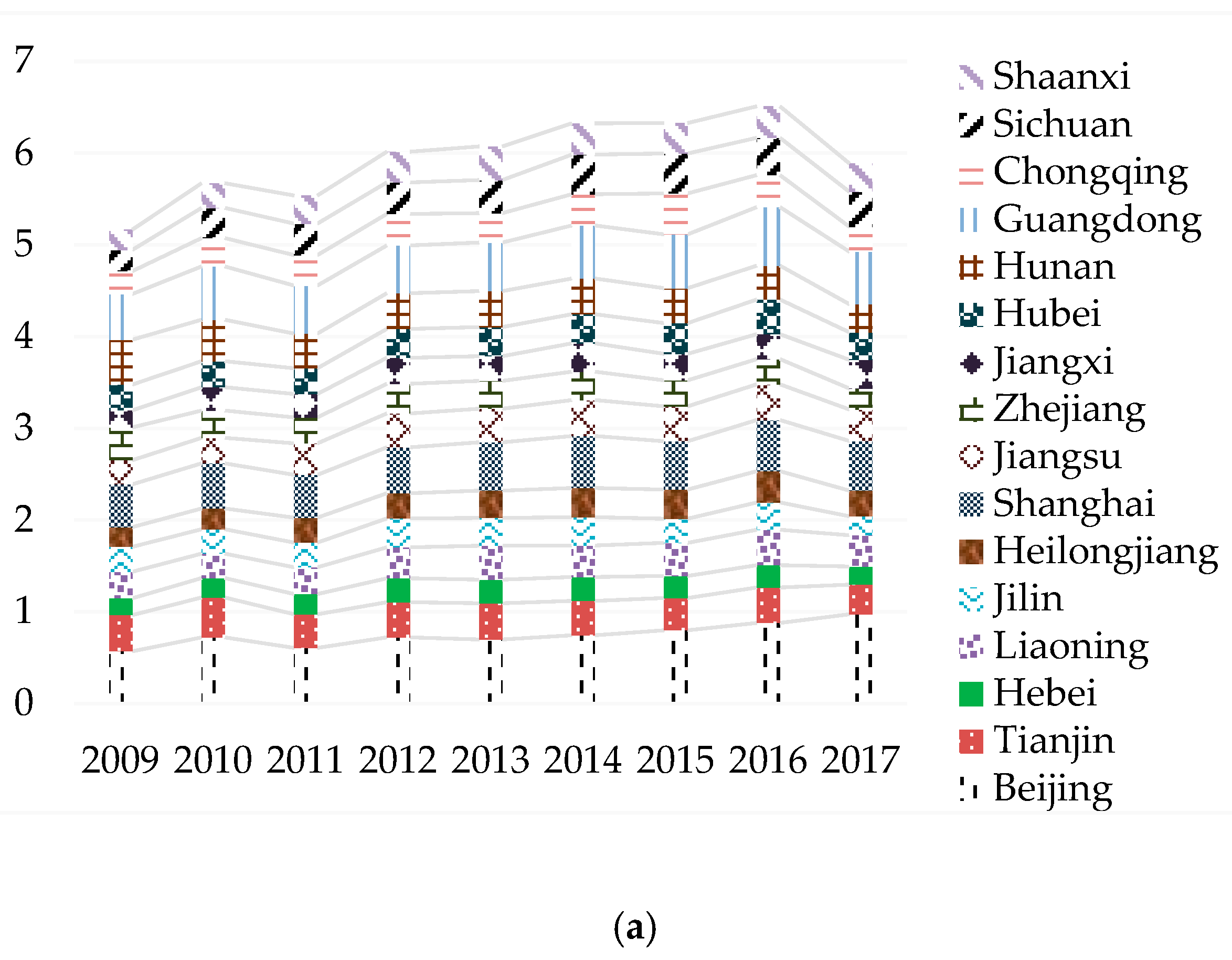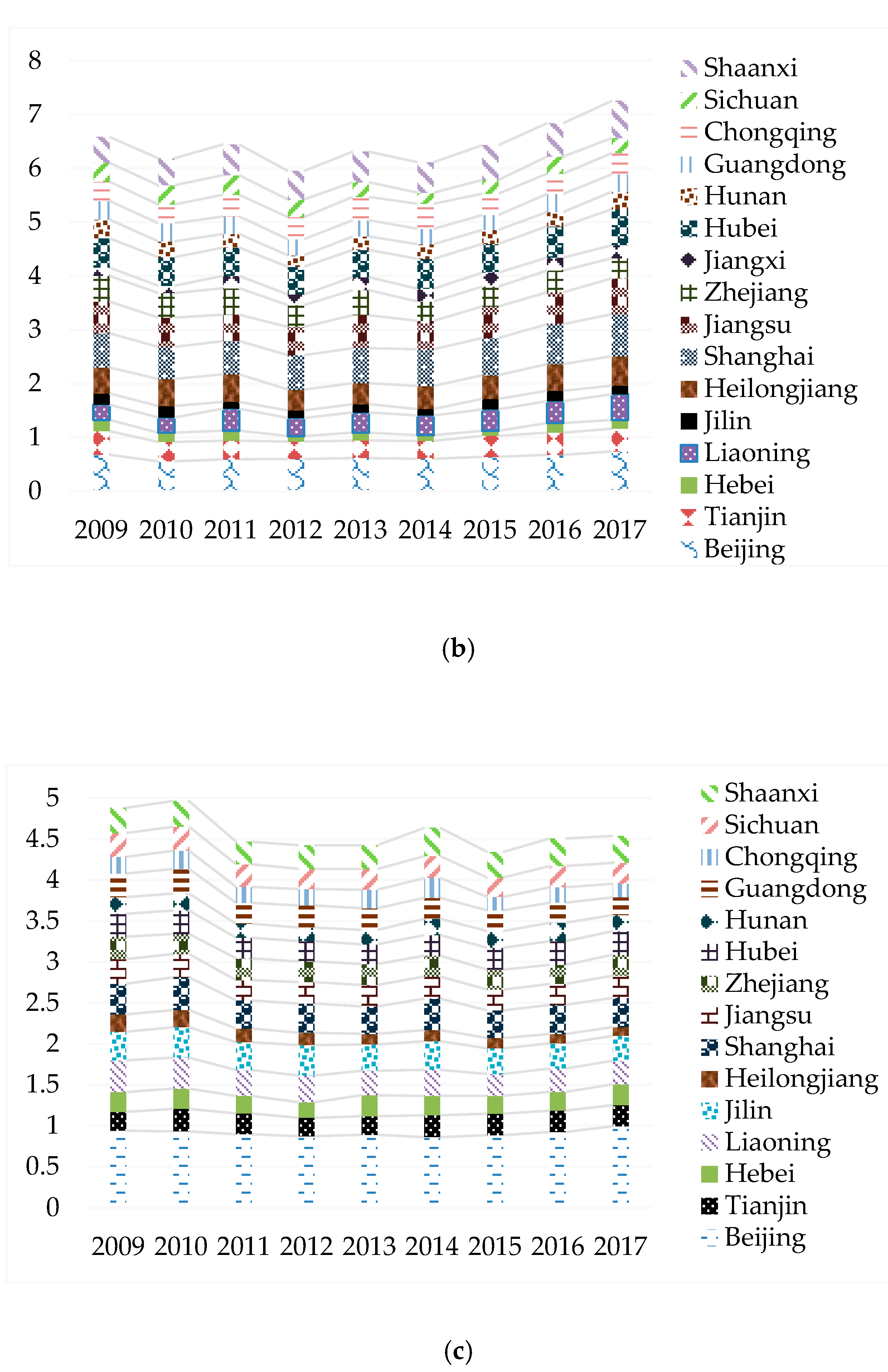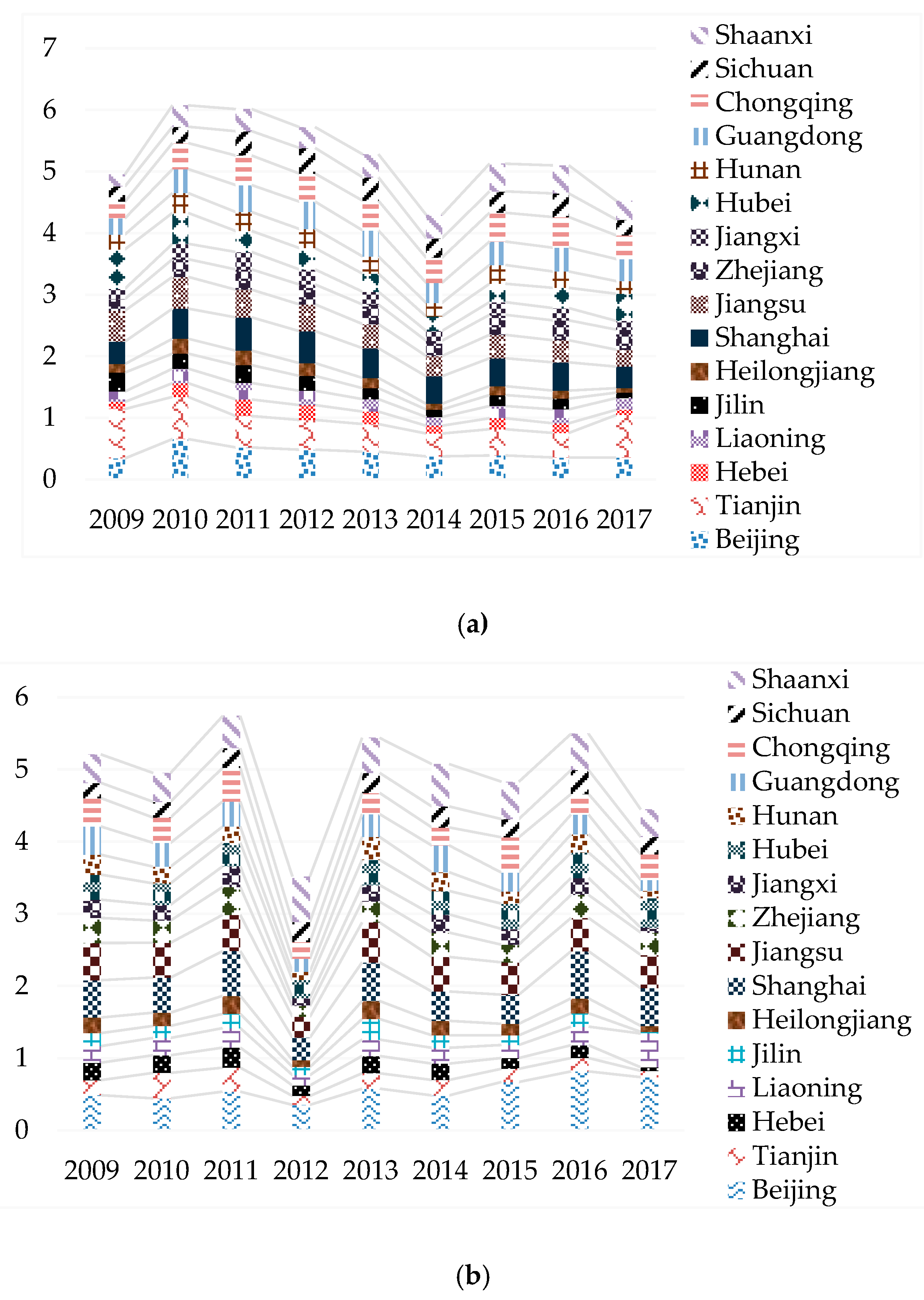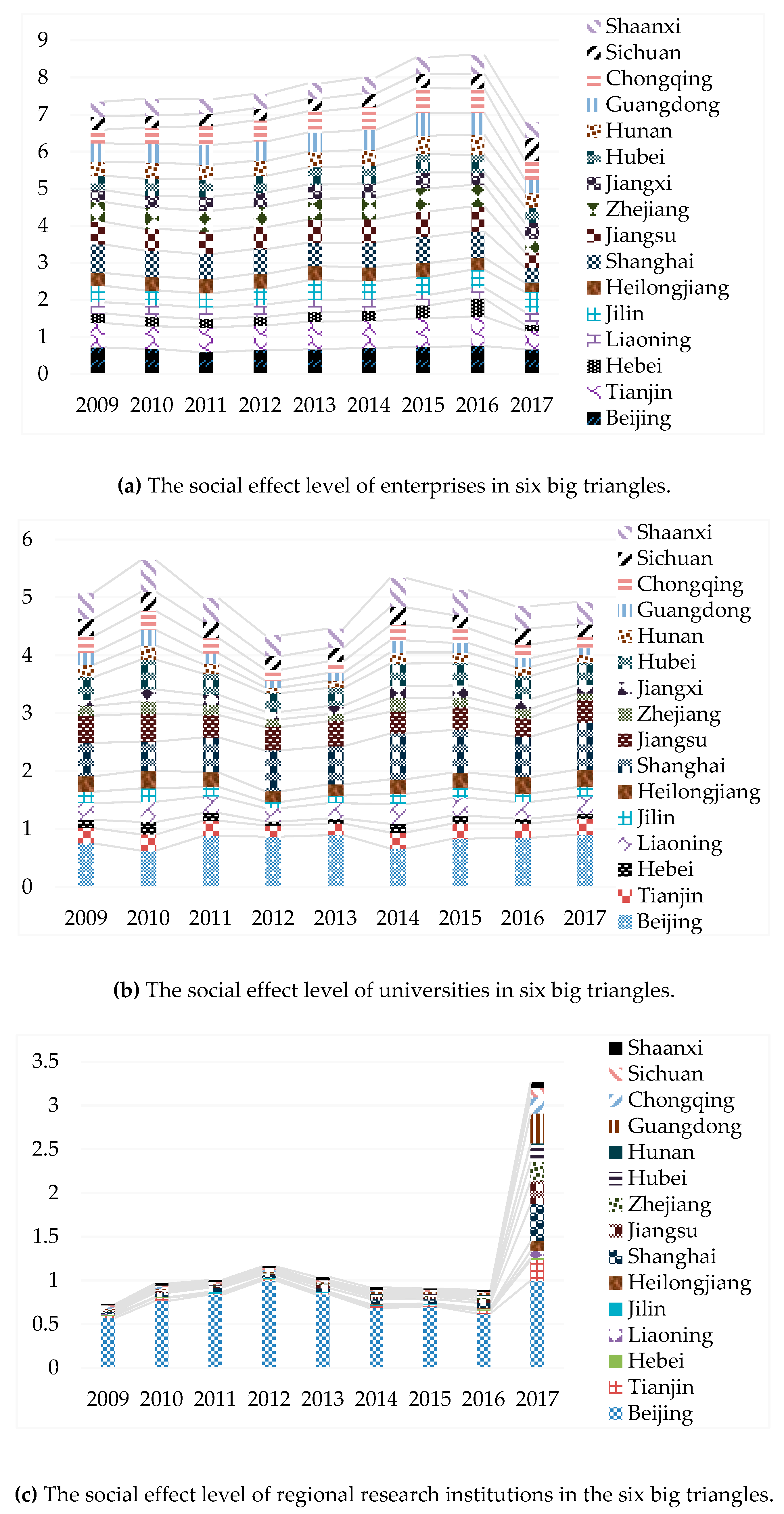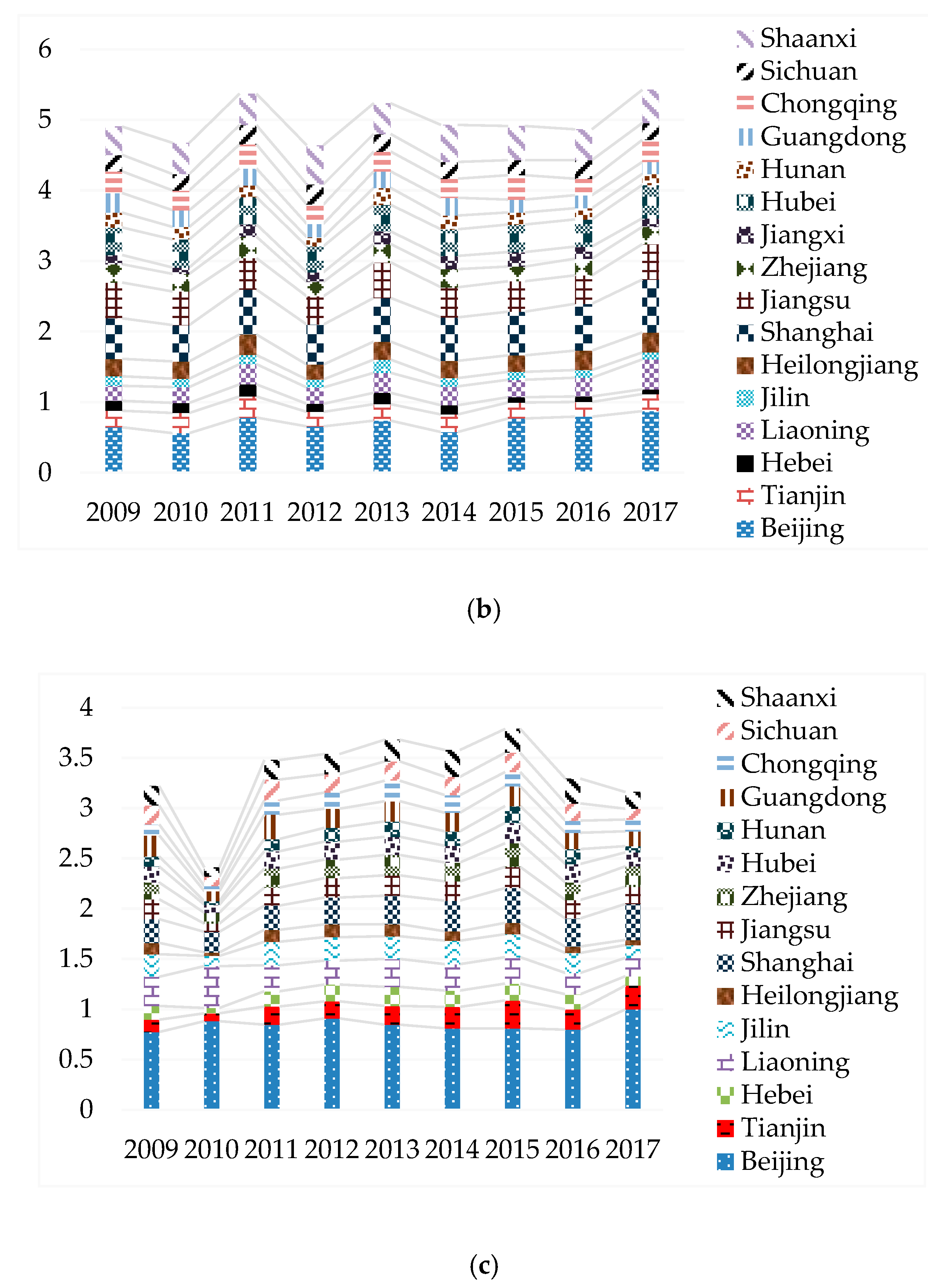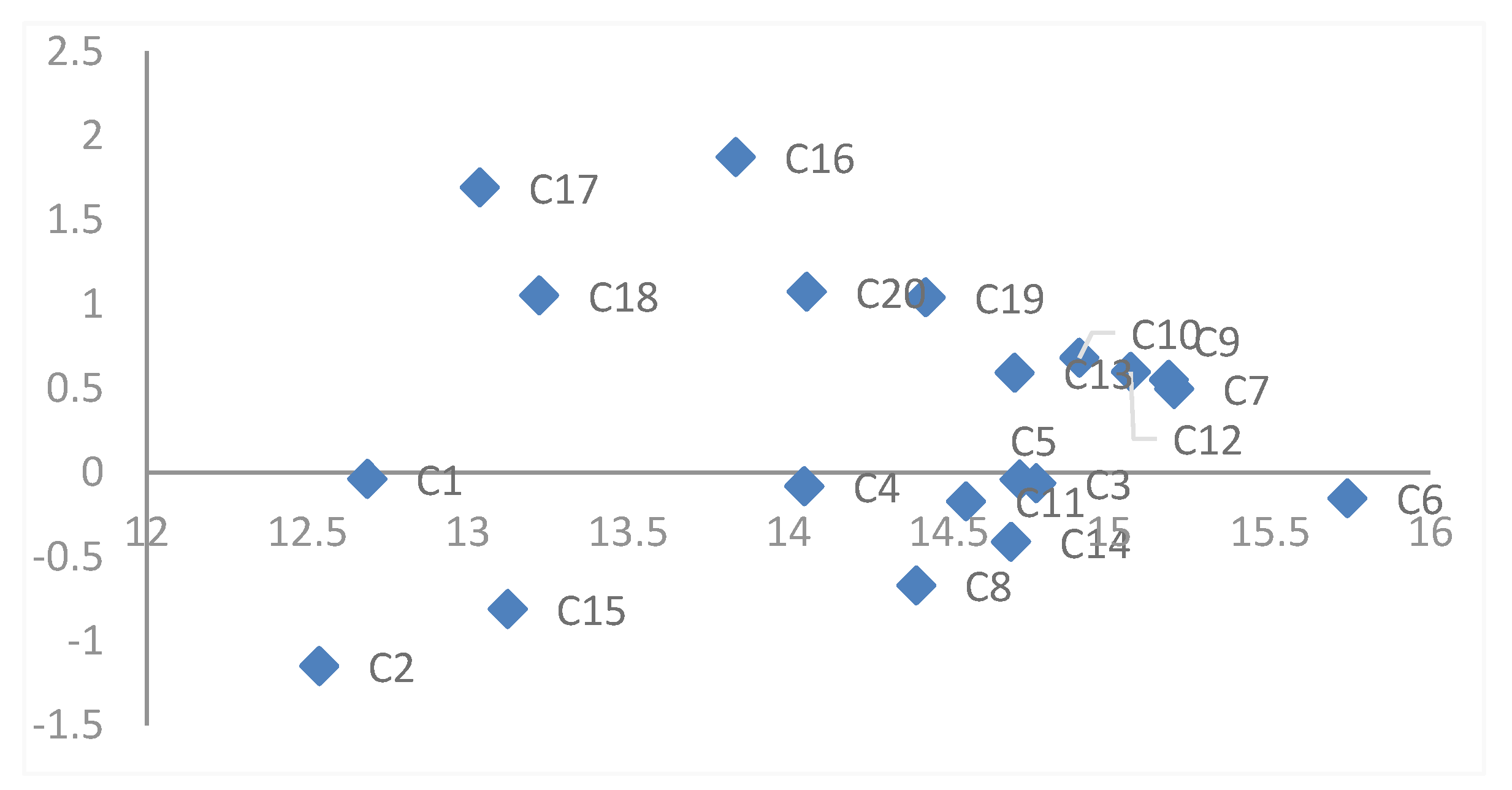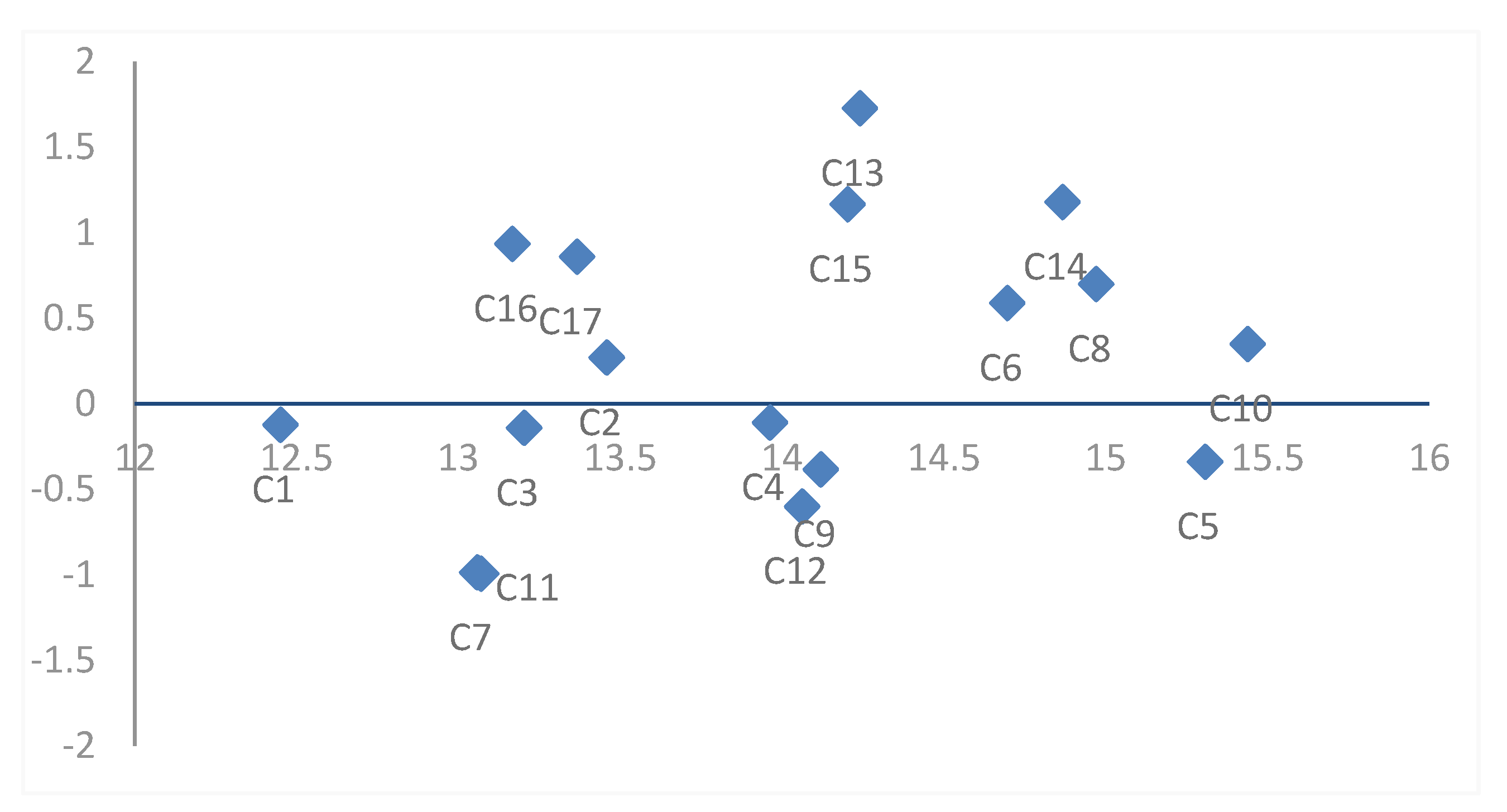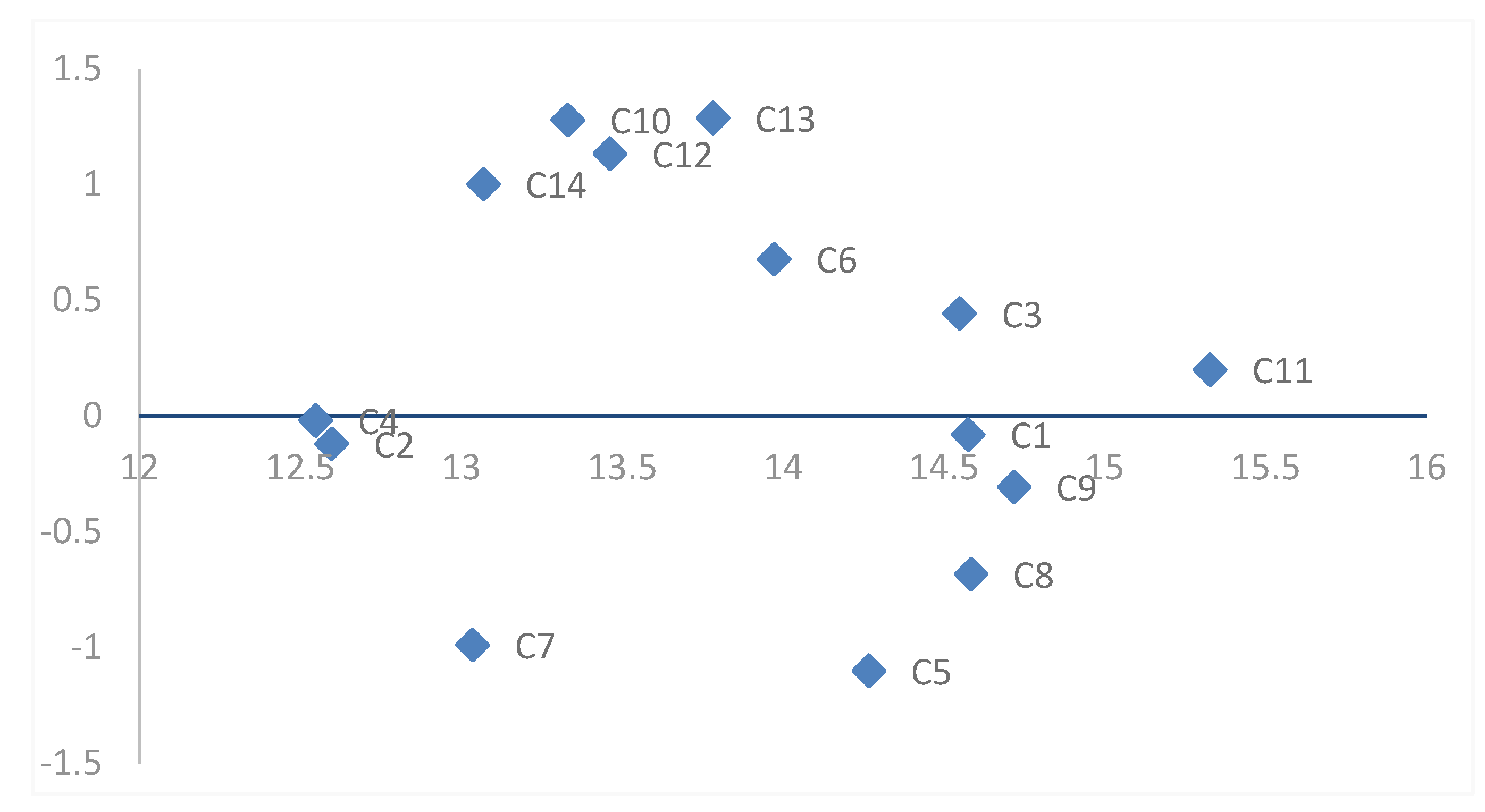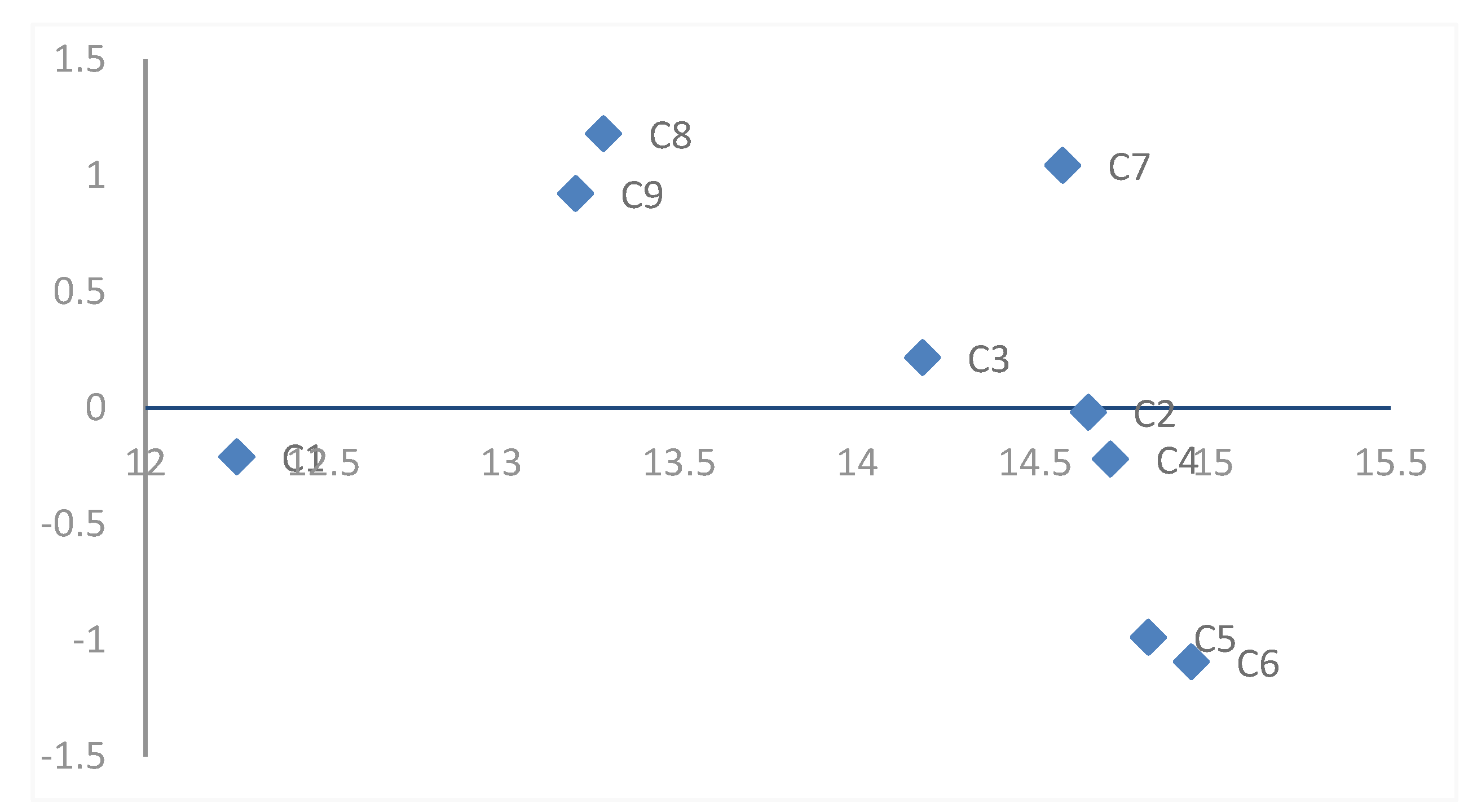1. Introduction
With the progress of science and technology, human beings are rapidly evolving from an industrial economic society to a knowledge economic society. Science and technology, as the source of the construction of an innovation-oriented country, has gradually become a new economic growth point and plays an increasingly important role in promoting the sustainable development of national and regional economy [
1]. At the same time, energy shortage and environmental pollution make the traditional economic development model unsustainable. Innovation has gradually become a powerful booster of national and regional economic sustainable development. The implementation of the innovation project provides high-quality intellectual services and gradually becomes the decision-making guarantee for the sustainable development of regional economy [
2].
At present, economic growth slowdown has become a global phenomenon, and China’s economic structural slowdown is increasingly prominent [
3]. Demand-side to pull the role of the economy gradually weakened, and the reform of the supply-side is imperative. In 2015, China proposed supply-side structural reform, one of the main purposes of which is to adjust the economic structure through innovation-driven development strategy and promote the smooth implementation of Made in China 2025 strategy [
4]. China’s regional economic development has not balanced for a long time, and the structural problems between regions and within regions are also very prominent. Traditional advantageous industries in some zones are no longer beautiful and emerging industries develop slowly. The driving force of export, investment and consumption has weakened, and the contradiction between supply and demand has become increasingly prominent [
5]. These problems are often the reflection of regional innovation ability and regional innovation performance. The root cause is that regional innovation factors cannot be effectively transformed into real productivity, thus affecting regional innovation performance and regional sustainable development [
6]. Therefore, effectively adjusting the allocation of regional innovation resources plays an important role in accelerating the formation of a regional economic system mainly supported by innovation, and promoting the sustainable development of regional economy.
Regional innovation system is an integral part of a national innovation system. Regional innovation performance is of great significance to regional economic sustainable development and national overall economic development [
7]. Heilongjiang province, an old industrial base in northeast China, ranked 22nd in China in 2017 with a GDP of 1.590268 billion yuan, up 6.4% year-on-year to 41,916 yuan, lower than the national average. In 2018, the GDP reached 1,636,162 billion yuan, ranking 23rd in China, with a year-on-year growth rate of 4.7%, lower than the national average and better than expected [
8]. The main reason lies in the lack of innovation drive in the case of the troika dynamic weakening. According to the evaluation report on China’s regional innovation capacity in 2018, the comprehensive innovation level index of Heilongjiang province dropped two places to 16th in the country. From the perspective of the scientific and technological innovation environment, Heilongjiang province has significantly improved its innovation environment, rising from 17th to 12th place [
9]. In 2017, the full-time equivalent of R&D personnel in Heilongjiang province was 47,406 person-years, which was in the middle of the whole country. However, the full-time equivalent of researchers is 29,660 person-years, which is in the middle and upper reaches of the country and has certain advantages in quantity. The total number of the three kinds of patents authorized is 18,221, which is in the middle and lower reaches of the country.
With the rapid development of China’s economy, the number of large and medium-sized state-owned enterprises from the original advantages gradually become disadvantages. Heilongjiang province has gradually lost the original advantages. From 2007 to 2017, the contribution of industry to Heilongjiang’s economic growth remained above 50%. Among them, the proportion of the added value of energy industry in the proportion of industries above the scale is highest at 72.9% and the lowest at 53.8%, and the growth rate is highest at 13.1% and the lowest at 6.3% [
8,
10]. The growth potential of a number of industries has not yet been fully unleashed, and the vitality of economic growth is insufficient. In the last 10 years, the innovation vitality of Heilongjiang regional enterprises is insufficient, and the quality of innovation output is average. The number of high-tech enterprises is obviously low and needs attention and improvement. The theoretical innovation and quantity of innovation in universities need to be further strengthened. The number of government research institutes in Heilongjiang decreased a lot, while the number of enterprise research institutes increased a little. The total quantity presents the decreasing trend, and Heilongjiang province still has certain development potential [
6,
9,
10].
There are many researches on regional innovation performance, but there is still a lack of analysis on the actual situation of Heilongjiang province. The setting of the existing index system is not reasonable, and the innovation performance of specific regions cannot be analyzed effectively. Most of the methods focus on the evaluation of static methods and lack of dynamic analysis methods for empirical research. Although scholars have found that there are many factors influencing regional innovation performance, there is a lack of systematic sorting and the study of influencing factors is scattered. Many innovation resources cannot be effectively converted into real productive forces, and their contribution to economic sustainable development is limited [
11].
The purpose of this study includes the following three aspects. (1) Based on relevant studies, the regional innovation performance dynamic evaluation index system and regional innovation subject dynamic evaluation index system of Heilongjiang province are constructed based on the current status of regional innovation. (2) Based on the current status of regional innovation, the science and technology output, economic output and social effect of enterprises, universities and research institutions in Heilongjiang province are effectively analyzed. (3) Through comparative analysis, the key factors affecting the regional innovation performance in Heilongjiang province are selected. The theoretical purpose of this study is not only to expand the research perspective and method of regional innovation performance evaluation, but also to enrich the regional innovation system theory and provide important theoretical support for the construction of a regional innovation system. The practical purpose of this study is not only to provide reference for the development strategies of regional innovation subjects, but also to contribute a little to the new path of comprehensive sustainable development of Heilongjiang province.
The following structure of this paper is as follows. The regional innovation review is in
Section 2.
Section 3 shows the research method and index system. Empirical results are listed in
Section 4.
Section 5 presents on the discussion analysis.
Section 6 summarizes the research conclusion and enlightenment of this paper, and points out the shortcomings of this paper.
4. Empirical Results
4.1. Data Source
In order to comprehensively analyze the regional innovation performance in Heilongjiang province, the regional innovation performance in Heilongjiang province is dynamically evaluated from the following two aspects: Regional innovation performance and each innovation subject in Heilongjiang province. Research data from 2010–2018 “China Statistical Yearbook of Science and Technology, China’s Environmental Statistical Yearbook, China Energy Statistical Yearbook and China Statistical Yearbook, Heilongjiang Statistical Yearbook, Heilongjiang Science and Technology Statistical Manual, China Regional Innovation Capacity Report, China Regional Innovation Index Report, 2018 National Large and Medium Sized Cities Update for the Prevention and Control of Environmental Pollution by Solid Waste and the Regional Environment Bulletin Data Documents and Materials”.
This study draws on relevant scholars’ research results and consults relevant experts’ suggestions. In this study, 16 regions in China, namely six growth triangles, were selected as the research objects. Growth triangle refers to the economic region of the inter-provincial domain cooperation, covering southeast China’s coastal, central, western and northeastern regions, which mainly includes the Beijing-Tianjin-Hebei metropolitan zone (Beijing, Tianjin and Hebei), the Yangtze River Delta economic zone, (Shanghai, Jiangsu and Zhejiang), the triangle economic zone (Hubei, Hunan and Jiangxi), the Pearl River Delta economic zone (due to Hong Kong and Macau University innovation system differences with China, here, we only include Guangdong province), west triangle economic zone (Sichuan, Chongqing and Shaanxi), and the northeast economic zone (Heilongjiang, Jilin and Liaoning), totaling six districts, including 16 provinces and municipalities directly under the central government. The six growth triangles are concentrated in enterprises, universities and research institutions (especially industrial enterprises and key universities above the scale). These zones are home to the country’s important scientific, educational and intellectual resources, with a large number of inputs and outputs in scientific research. As the relevant data on innovation of Jiangxi provincial research institutions cannot be obtained, the innovation performance of Jiangxi provincial research institutions has not been evaluated.
In this study, the combined evaluation method of drift degree based on entropy weight method, maximum deviation method, TOPSIS method and grey relational degree method was used to evaluate the innovation performance in Heilongjiang province as a whole and each innovation subject from 2009 to 2017. The evaluation results are shown in
Appendix C. In order to compare and analyze the innovation performance in Heilongjiang province and each subject, this paper evaluates the science and technology output, economic output, social effect and innovation performance of the six major triangle regions and each innovation subject, and draws
Figure 3,
Figure 4,
Figure 5,
Figure 6 and
Figure 7 for visual display.
4.2. Dynamic Evaluation of Regional Overall Innovation Performance
Figure 3 shows regional overall science and technology output, regional economic output and regional social effect.
As shown in
Figure 3a, from a static perspective, Heilongjiang ranked 3 among 16 provinces in the six big triangles in 2017. The level of science and technology output was 0.4421, about 0.1 lower than that of Shanghai, and slightly higher than that of Shaanxi province, about four times that of Hebei province. Dynamically, from 2009 to 2017, Heilongjiang province first dropped and then rose in the ranking of 16 provinces in the six big triangles. The overall level of science and technology output showed an upward trend, reaching a peak of 0.4421 in 2017, higher than other regions except Beijing and Shanghai.
As shown in
Figure 3b, from a static perspective, Heilongjiang province ranked 14th among 16 provinces in the six big triangles in 2017. The level of economic output was 0.1035, much lower than that of Beijing, Shanghai and Guangdong. Heilongjiang is about one-sixth the level of Beijing’s economic output, only slightly higher than Jiangxi and Hebei, and at the end of the range. Dynamically, from 2009 to 2017, Heilongjiang province showed a slow rise in the ranking of 16 provinces in the six big triangles. However, the trend is not obvious. Heilongjiang province hovered between 14th and 16th, and the overall level of economic output presented a slow downward trend with a relatively low decline rate.
As shown in
Figure 3c, from a static perspective, Heilongjiang province ranked 15th among the 16 provinces in the six big triangles in 2017. The social effect level of Heilongjiang province is lower than that of other regions, about 1/4 of the economic effect level of Beijing, which is at the end of the social effect level. Dynamically, from 2009 to 2017, Heilongjiang province’s ranking among the 16 provinces in the six big triangles showed a declining trend, with a relatively large decline. The overall level of social effect increased first and then decreased, reaching a peak of 0.3403 in 2012. In 2017, the level of social effect decreased to 0.2039, with a relatively significant decline.
As shown in
Figure 3d, from a static perspective, Heilongjiang ranked 12th among 16 provinces in the six big triangles in 2017. The innovation performance level was 0.2692, higher than that of Hebei, Jilin, Jiangxi and Hunan, and about 1/3 of that of Beijing, ranking in the middle and lower level. Dynamically, from 2009 to 2017, Heilongjiang province fluctuated between 12 and 15 in the ranking of 16 provinces in the big six triangles. The overall trend shows a slow fluctuation rising trend, but the trend is not obvious. The highest level of innovation performance in 2017 was 0.2692.
4.3. Dynamic Evaluation of Innovation Performance of Regional Innovation Subjects
4.3.1. Dynamic Evaluation of Science and Technology Output Level
Figure 4 shows science and technology output of each innovation subject.
As shown in
Figure 4a, from a static point of view, in 2017, the science and technology output of enterprises in Heilongjiang province ranked 12th among the 16 provinces in the six big triangles. The level of science and technology output was 0.2800, higher than that of Hebei, Jilin, Zhejiang and Chongqing, and about 1/3 of that of Beijing. Dynamically, from 2009 to 2017, Heilongjiang province rose from 15th to 12th among the 16 provinces in the big six triangles, showing a slow development trend. The level of science and technology output showed a slow upward trend, and the upward trend was obvious compared with other provinces.
As shown in
Figure 4b, from a static point of view, the subject of universities in Heilongjiang province ranked 6th among 16 provinces in the six big triangles in 2017. The science and technology output level of universities is 0.5440, which is higher than that of Tianjin, Hebei, Liaoning, Zhejiang, Jiangxi, Hunan, Guangdong, Chongqing and Sichuan, and about 3/4 of that of Beijing and Shanghai. Dynamically, from 2009 to 2017, Heilongjiang province showed a slight fluctuation in the ranking of 16 provinces in the big six triangles. The overall ranking showed a slow upward trend, while the level of science and technology output showed a rapid upward trend, which was not changed much compared with other regions.
As shown in
Figure 4c, from a static point of view, the subject of research institutions in Heilongjiang province was ranked 15th among the 16 provinces in the six big triangles in 2017. The level of science and technology output of research institutions is 0.1069, about 1/10 of that of Beijing and at the end of the range. Dynamically, from 2009 to 2017, Heilongjiang province was ranked in the top 15 of 16 provinces in the big six triangles, that is, the bottom position. The overall level of science and technology output showed a downward trend, which was more obvious compared with other regions.
4.3.2. Dynamic Evaluation of Economic Output Level
Figure 5 shows economic output of each innovation subject.
As shown in
Figure 5a, from a static point of view, Heilongjiang province ranked 16th among 16 provinces in the six big triangles in 2017. The economic output level is 0.0720, which is about 1/7 of the economic output level of Tianjin and at the end of the economic output level. Dynamically, from 2009 to 2017, Heilongjiang province ranked 16th among the 16 provinces in the six big triangles. The level of economic output showed a trend of fluctuation and decline, and the decline was more obvious than that in most zones.
As shown in
Figure 5b, from a static point of view, the subject of universities in Heilongjiang province ranked 13th among 16 provinces in the six big triangles in 2017. The economic output level of universities is 0.0842, higher than that of Hebei, Jilin and Jiangxi, and about 1/7 of the economic output level of Beijing, which was at the end of the economic output level. Dynamically, from 2009 to 2017, Heilongjiang province ranked 12-16 among the 16 provinces in the six big triangles. The overall ranking showed a slow upward trend, but the trend was not obvious. The overall level of economic output showed a fluctuating trend. Compared with other regions, the degree of fluctuation is relatively large, with significant differences.
As shown in
Figure 5c, from a static point of view, the subject of research institutions in Heilongjiang province was ranked 10th among the 16 provinces in the six big triangles in 2017. The economic output level of research institutions is 0.0264, which was about 1/20 of Beijing’s economic output level and at the end of the economic output level. Dynamically, from 2009 to 2017, Heilongjiang province showed a slow rise in the ranking of 16 provinces in the six big triangles. The overall level of economic output showed a slow upward trend. Compared with other regions, the upward trend was slow and less volatile.
4.3.3. Dynamic Evaluation of Social Effect Level
Figure 6 shows social effect of each innovation subject.
As shown in
Figure 6a, from a static perspective, Heilongjiang province ranked 15th among the 16 provinces in the six big triangles in 2017. The level of social effect was 0.2501, which was only slightly higher than that of Hebei province, and about 1/3 of that of Beijing, which was at the end of the social effect level. Dynamically, from 2009 to 2017, Heilongjiang province showed a slow decline and fluctuation in the ranking of 16 provinces in the six big triangles. The overall social effect level presented a slow decline trend. Compared with other regions, the decline was larger.
As shown in
Figure 6b, from a static point of view, the subject of universities in Heilongjiang province ranked 7th among 16 provinces in the six big triangles in 2017. The social effect level of the subject of universities was 0.3016, which was about 1/3 of the innovation performance level of Beijing, and was in the middle position of the social effect level. Dynamically, from 2009 to 2017, Heilongjiang province rose from 10th to 7th among the 16 provinces in the six big triangles. The level of social effect fluctuates. Compared with other regions, the degree of fluctuation was small and there was room for improvement.
As shown in
Figure 6c, from a static point of view, the subject of research institutions in Heilongjiang province was ranked 9th among the 16 provinces in the six big triangles in 2017. The social effect level of research institutions was 0.1145, which was about 1/10 of the social effect level of Beijing, and was in the middle of the social effect level. Dynamically, from 2009 to 2017, Heilongjiang province rose from 15th to 9th among the 16 provinces in the six big triangles. The overall social effect level presented a slow rising trend. Compared with other regions, the upward trend was slow and the degree of fluctuation was slow.
4.3.4. Dynamic Evaluation of Innovation Performance Level of Each Subject
Figure 7 shows innovation performance of each innovation subject.
As shown in
Figure 7a, from a static perspective, Heilongjiang province ranked 15th among 16 provinces in the six big triangles in 2017. The innovation performance level was 0.1612, which was only slightly higher than that of Hebei province and about 1/4 of that of Beijing, which was at the end of the innovation performance level. Dynamically, Heilongjiang province showed 15 or 16 fluctuations in the ranking of 16 provinces in the six big triangles from 2009 to 2017. The overall trend of innovation performance was fluctuating. The innovation performance level showed a trend of slow rise and then slow decline, and the highest innovation performance level in 2013 was 0.2230.
As shown in
Figure 7b, from a static point of view, the subject of universities in Heilongjiang province ranked the 8th among 16 provinces in the six big triangles in 2017. The innovation performance level of universities was 0.2847, which was about 1/4 of that of Beijing. Dynamically, Heilongjiang province fluctuated in the rankings of 16 provinces in the six big triangles from 2009 to 2017. The overall ranking showed a slow upward trend, but the trend was not obvious. The innovation performance level showed a trend of rising first, then falling and then rising. The highest level of innovation performance in 2011 was 0.2896, which was similar to that of 2017.
As shown in
Figure 7c, from a static point of view, the research institutions in Heilongjiang province ranked 15th among the 16 provinces in the six big triangles in 2017. The innovation performance level of the research institutions subject was 0.0511, about 1/10 of the innovation performance level of Beijing, and it was at the end of the innovation performance level. Dynamically, Heilongjiang province ranked 15th out of 16 provinces in the six big triangles from 2009 to 2017, which was the end position. The overall innovation performance level showed an upward trend and then a downward trend, and the highest innovation performance level in 2012 was 0.1290.
4.4. Key Factors Influencing Regional Innovation Performance
This study selected key factors of regional innovation performance in Heilongjiang province. On the basis of using objective data to evaluate the innovation performance of each innovation subject, this study used subjective data to select the key factors influencing the regional innovation performance and the innovation performance of each innovation subject.
4.4.1. Key Factors of Regional Overall Innovation Performance
This study selects the existing regional innovation performance evaluation system and the factors outside the system. The comprehensive influence was calculated according to steps 1 to 7, as shown in
Table 8. According to step 8, the cause-center distribution diagram was constructed, as shown in
Figure 8.
Table 8 and
Figure 8 show the key factors influencing regional overall innovation performance. The reason factor is the core factor that affects the regional innovation performance. The factor value represents the influence degree of other factors. The reasons are listed as follows: C16 > C17 > C20 > C18 > C19 > C10 > C12 > C13 > C9 > C7. The result factor is the direct factor that affects the regional innovation performance and is greatly influenced by other factors. The ranking of the results is C1 > C5 > C3 > C4 > C6 > C11 > C14 > C8 > C15 > C2. The degree of centrality represents the relationship between this factor and other factors. The larger the value, the greater the influence of this factor on the decision. The order of centrality is C6 > C7 > C9 > C12 > C10 > C3 > C5 > C13 > C14 > C11 > C19 > C8 > C20 > C4 > C16 > C18 > C15 > C17 > C1 > C2.
4.4.2. Key Factors of Enterprise Innovation Performance
This study selects the existing regional enterprise innovation performance evaluation system and the factors outside the system. The comprehensive influence was calculated according to steps 1 to 7, as shown in
Table 9. According to step 8, the cause-center distribution diagram was constructed, as shown in
Figure 9.
Table 9 and
Figure 9 show the key factors for enterprise innovation performance. The reason factor is the core factor that affects the innovation performance of regional enterprises, and the factor value represents the influence degree of other factors. The ranking of causes is C13 > C14 > C15 > C16 > C17 > C8 > C6 > C10 > C2. The result factor is the direct factor that affects the innovation performance of the subject of the regional enterprises. The ranking of the results is C4 > C1 > C3 > C5 > C9 > C12 > C7 > C11. The degree of centrality represents the relationship between this factor and other factors. The larger the value, the greater the influence of this factor on the decision. The order of degree of centrality is C10 > C5 > C8 > C14 > C6 > C13 > C15 > C9 > C12 > C4 > C2 > C17 > C3 > C16 > C11 > C7 > C1.
4.4.3. Key Factors of University Innovation Performance
This study selects the existing regional universities innovation performance evaluation system and the factors outside the system. The comprehensive influence was calculated according to steps 1 to 7, as shown in
Table 10. According to step 8, the distribution diagram of cause-center degree was constructed, as shown in
Figure 10.
Table 10 and
Figure 10 show the key factors for the universities’ innovation performance. The reason factor is the core factor that affects the innovation performance of regional universities. The factor value represents the influence degree of other factors. The ranking of causes is C13 > C10 > C12 > C14 > C6 > C3 > C11. The result factor is the direct factor that affects the innovation performance of the subject in regional universities, and is greatly influenced by other factors. The ranking of the results is C4 > C1 > C2 > C9 > C8 > C7 > C5. The degree of centrality represents the relationship between this factor and other factors. The larger the value, the greater the influence of this factor on the decision. The order of centrality is C11 > C9 > C8 > C1 > C3 > C5 > C6 > C13 > C12 > C10 > C14 > C7 > C2 > C4.
4.4.4. Key Factors of Research Institutions’ Innovation Performance
This study selects the existing regional research institutions’ innovation performance evaluation system and the factors outside the system. According to steps 1 to 7, the comprehensive influence was calculated, as shown in
Table 11. According to step 8, the cause-center distribution diagram was constructed, as shown in
Figure 11.
Table 11 and
Figure 11 show the key factors for the research institutions’ innovation performance. The reason factor is the core factor that affects the subject innovation performance of regional research institutions. The factor value represents the influence degree of other factors. The reasons are ranked C8 > C7 > C9 > C3. The result factor is the direct factor that affects the innovation performance of the subject of the regional research institutions. The ranking of the results is C2 > C1 > C4 > C5 > C6. The degree of centrality represents the relationship between this factor and other factors. The larger the value, the greater the influence of this factor on the decision. The order of center degree is C6 > C5 > C4 > C2 > C7 > C3 > C8 > C9 > C1.
6. Conclusions and Future Prospects
The coordinated development of regional innovation in Heilongjiang province plays an important role in stimulating the regional innovation and entrepreneurship vitality. This can not only accelerate the formation of a regional economic system with innovation as the main guide and support, but also play an important role in promoting the healthy and sustainable development of Heilongjiang’s regional economy. Although, at present, Heilongjiang province is rich in innovation factor endowment and has great potential for innovation-driven development, many innovation resources cannot be effectively converted into real productive forces and their contribution to economic development is limited. The allocation of regional innovation resources in Heilongjiang province should be adjusted scientifically and effectively to alleviate the shortage of regional innovation-driven development.
In this study, the combined evaluation method of drift degree based on entropy weight method, maximum deviation method, TOPSIS method and grey relational degree method was used to carry out the dynamic evaluation of regional innovation performance in Heilongjiang province. The grey-DEMATEL model was further applied to select the key factors influencing the regional innovation performance in Heilongjiang province. The purpose of this study is to summarize the innovation experience of each innovation subject and select the key factors that influence the regional innovation performance in Heilongjiang province. On this basis, this study puts forward countermeasures to improve regional innovation performance in Heilongjiang province based on regional economic development. The results of this study are as follows.
(1) In the last 10 years, the innovation vitality of enterprises was insufficient, and the quality of innovation output was average in Heilongjiang province. The number of high-tech enterprises was obviously low. The theoretical innovation and quantity of innovation in universities should be further strengthened. The number of government research institutes in Heilongjiang decreased a lot, while the number of enterprise research institutes increased a little. The total quantity presented the decreasing trend, while Heilongjiang province still had certain development potential.
(2) The innovation performance level of Heilongjiang province ranked second in northeast China, and its innovation performance level and ranking rose steadily. Compared with other regions, the innovation performance level of Heilongjiang province was in the middle and lower level, which was only slightly higher than that of Hebei, Jilin, Jiangxi and Hunan. However, the trend was not obvious, and the ranking was in a fluctuating trend.
(3) The innovation performance level of enterprises in Heilongjiang province was at the end, which was only slightly higher than that in Hebei province. The overall trend showed a slow rise first and then a slow decline. The innovation performance level of universities in Heilongjiang province was in the middle position, showing the trend of first rising, then falling and then rising. The overall ranking showed a slow upward trend. The innovation performance level of research institutions in Heilongjiang province was in the terminal position. The overall innovation performance level showed a trend of first rising and then declining, with the largest decline of about 0.08 level.
(4) At present, the degree of marketization, financial environment, intellectual property system, transformation of scientific and technological achievements and human capital level are the core factors influencing the regional innovation performance in Heilongjiang province. R&D investment, human resources investment, enterprise management system and enterprise organization structure are the core factors that affect the innovation performance of enterprises in Heilongjiang province. The number of scientists and engineers in universities, the number of senior titles in teaching and research personnel, and the total internal expenditure in science and technology expenditure are the core factors that affect the innovation performance of universities in Heilongjiang province. The total number of personnel engaged in research activities, the number of R&D instruments and equipment above 100,000 yuan, the qualification recognized by the state or departments and the number of institutions are the core factors that affect the innovation performance of regional research institutions in Heilongjiang province.
This study lays a theoretical foundation for the formulation and implementation of the regional innovation-driven development strategy of Heilongjiang province, and provides practical guidance for the regional supply-side structural reform and the promotion of regional economic development in Heilongjiang province. In order to promote the regional sustainable innovation, this study puts forward the following suggestions. (1) Regional enterprises in Heilongjiang province should fully rely on universities and research institutes to establish strategic alliances of industry, university and research institutes within the region. When regional enterprises carry out innovation activities, they should pay attention to the guiding role of the market and seek inspiration for innovation from the market. At the same time, the monographs, papers, intellectual property and other innovative achievements in Heilongjiang province are transformed into products to meet people’s needs. (2) The government should strengthen the cooperation between industry, university and research institutes in Heilongjiang province. The government should also fundamentally promote the comprehensive cooperation between universities and enterprises in Heilongjiang province and realize the industrialization of scientific and technological achievements. (3) Research institutes in Heilongjiang province should issue corresponding incentive policies. These policies should improve the enthusiasm and initiative of scientific and technological personnel so as to produce more high-level scientific and technological achievements. In particular, the authorization of patents can improve the conversion rate of scientific and technological achievements.
Although these important results were obtained in this study, there are some shortcomings, which are also an important direction for future research. First, the development proposal has very good applicability to promote the regional development of Heilongjiang province, and further study is needed for different regions. Second, the evaluation index system in this study can be used as the basic index system for the innovation performance evaluation of regions and various innovation subjects. Future study can be further expanded and improved for different regions.
